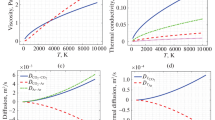Abstract
Experimental studies have shown that a mixture of molten metal and water can support the propagation of a quasi-steady vapor explosion wave. Analysis of steadily propagating vapor explosion waves has been carried out by applying the one-dimensional conservation laws of mass, momentum and energy and appropriate equations of state to a homogeneous mixture of molten tin, water and steam. The effects of void fraction, melt/water volume fraction and melt temperature on the Hugoniot curves have been considered. For low temperature melts, the Hugoniot curve lies partially inside the saturation dome and a Chapman-Jouguet (CJ) detonation point occurs only for low void fractions. For high melt temperatures, the downstream states lie entirely outside the saturation region. Increasing the volatility of the coolant or the addition of chemical reactions increases the predicted CJ detonation pressure and velocity. CJ deflagration solutions were obtained in all cases. The existence of a CJ detonation or CJ deflagration for a multiphase fuel-coolant mixture has yet to be substantiated experimentally and nonequilibrium effects may play a role in the divergence between theory and experiments.
Similar content being viewed by others
References
Anderson R, Armstrong D, Cho D, Kras A (1988) Experimental and analytical study of vapour explosions in stratified geometries. ANS Proc 1988 National Heat Transfer Conf 3:236–243
Baines M (1984) Preliminary measurements on steam explosion work yields in a constrained system. First UK Nat Conf on Heat Transfer, Inst Chem Eng Symp Series 86:97–108
Board SJ, Hall RW, Hall RS (1975) Detonation of fuel coolant explosions. Nature 254:319–321
Board SJ, Hall RW (1977) Recent advance in understanding large scale vapour explosions. Proc 3rd specialist meeting on sodium/fuel interactions in fast reactors, Tokyo SNI 6/7
Bürger M, Carachalios C, Kim DS, Unger H (1986) Theoretical investigation on the fragmentation of drops of melt with respect to the description of thermal detonations (vapor explosions) and their application in the code FRADEMO. Commission of the European Communities Rept EUR 10660 EN
Chaves H, Kurschat T, Meier GEA (1990) Evaporation waves in fluids of high molar specific heat. In: Meier GEA, Thompson PA (eds) Adiabatic waves in liquid-vapor systems. Springer-Verlag, Berlin New York Heidelberg pp13–24
Ciccarelli G, Frost DL, Zarafonitis C (1991) Dynamics of explosive interactions between molten tin and water in stratified geometry. In: Kuhl AL, Leyer J-C, Borisov AA, Sirignano WA (eds) Progress in Astronautics and Aeronautics 134, AIAA Inc Washington, pp 307–325
Condiff DW (1982) Contributions concerning quasi-steady propagation of thermal detonations through dispersions of hot liquid fuel in cooler volatile liquid coolants. Int J Heat Mass Transfer 25:87–98
Corradini ML, Kim BJ, Oh MD (1988) Vapour explosions in light water reactions: a review of theory and modelling. Prog Nucl Energy 22:1–117
Fletcher DF, Anderson RP (1989) A review of pressure-induced propagation models of the vapour explosions process. Prog Nucl Energy 23:137–179
Fowles GR (1990) Vapor detonations in superheated fluids. In: Meier GEA, Thompson PA (eds) Adiabatic waves in liquid-vapor systems. Springer-Verlag, Berlin New York Heidelberg pp 407–416
Fröhlich G (1989) Propagation of fuel coolant interactions in multijet experiments. Proc 4th Int Topical Meeting on Nuclear Reactor Thermal Hydraulics, Karlsruhe, 1:282–289
Frost DL, Ciccarelli G (1988) Dynamics of explosive interactions between multiple drops of tin and water. In: Kuhl AL, Bowen JR, Leyer J-C, Borisov A (eds) Progress in Astronautics and Aeronautics 114 AIAA Inc Washington, pp 451–473
Fry CJ, Robinson CH (1979) Experimental observations of propagating thermal interactions in metal/water systems. Proc 4th CSNI specialist meeting on fuel-coolant interaction in nuclear reactor safety, Bournemouth UK
Iida T, Guthrie RIL (1988) The physical properties of liquid metals. Clarendon Press, Oxford
Keenan JH, Keyes FG, Hill PC, Moore JG (1969) Steam tables. John Wiley and Sons, New York
Kirkwood JG, Montroll EW (1942) The pressure wave produced by an underwater explosion IL OSRD Rept 676
Labuntsov DA, Avdeev AA (1981) Theory of boiling discontinuity. Teplophizika Vysokikh Temperatur 19:552–556
Reid RC (1983) Rapid phase transitions from liquid to vapor. Adv Chem Eng 12:105–208
Reynolds WC (1979) Thermodynamic properties in SI. Stanford University Press, Stanford
Scott E, Berthoud GJ (1978) Multiphase thermal detonation. In: Bankoff SG (ed) Topics in two-phase heat transfer and flow. ASME
Sharon A, Bankoff SG (1978) Propagation of shock waves in a fuel-coolant mixture. In: Bankoff SG (ed) Topics in two-phase heat transfer and flow. ASME
Sharon A, Bankoff SG (1981) On the existence of steady super-critical plane thermal explosions. Int J Heat Mass Transfer 24:1561–1572
Shepherd JE, McCahan S, Cho J (1990) Evaporation wave model for superheated liquids. In: Meier GEA, Thompson PA (eds) Adiabatic waves in liquid-vapor systems. Springer-Verlag, Berlin New York Heidelberg, pp 3–12
Wallis GB (1969) One-dimensional two-phase flow. McGraw-Hill, Toronto
Author information
Authors and Affiliations
Additional information
This article was processed using Springer-Verlag TEX Shock Waves macro package 1990.
Rights and permissions
About this article
Cite this article
Frost, D.L., Lee, J.H.S. & Ciccarelli, G. The use of Hugoniot analysis for the propagation of vapor explosion waves. Shock Waves 1, 99–110 (1991). https://doi.org/10.1007/BF01414905
Received:
Accepted:
Issue Date:
DOI: https://doi.org/10.1007/BF01414905



